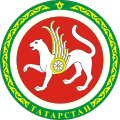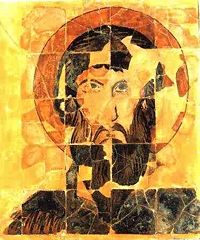Old Great Bulgaria

|
| History of Bulgaria | |
 |
|
| Prehistory | |
|---|---|
| Odrysian kingdom | |
| Roman Thrace | |
| Old Great Bulgaria | |
| First Bulgarian Empire | |
| Byzantine Bulgaria | |
| Second Bulgarian Empire | |
| Early Ottoman Bulgaria | |
| National Awakening | |
| Tsardom of Bulgaria | |
| People's Republic of Bulgaria | |
| Republic of Bulgaria | |
|
|
 History of Tatarstan |
|---|
| Great Bulgaria |
| Khazars |
| Volga Bulgaria |
| Kipchaks |
| Mongol invasion |
| Golden Horde |
| Khanate of Kazan |
| Muscovy |
| Kazan Governorate |
| Idel-Ural State |
| Tatar ASSR |
| Republic of Tatarstan |
Old Great Bulgaria or Great Bulgaria (Bulgarian: Стара Велика България; Παλαιά Μεγάλη Βουλγαρία in Byzantine chronicles; alternative name: Onoguria/Onoghuria) was а term used by Byzantine historians to refer to the territories controlled by the Bulgar ruler Kubrat in the 7th century north of the Caucasus mountains in the steppe between the Dniester and Lower Volga[1].
Contents |
Kubrat
Kubrat (also Kurt or Houvrat) was of the kingly Dulo clan[2] and the rightful heir of the Bulgar throne. He spent his adolescence in the Byzantine Empire, where he was educated and baptised[3], while his maternal uncle Organa was a regent over his tribe.
Around 628 Kubrat returned to his fatherland, took the leadership over his people most probably with the approval of the Avar khagan. He soon managed to overthrow Avar domination and also to secede from the Western Turkic Khaganate (which was entangled in dynastic wars).
Establishment
Between 630 and 635 Khan Kubrat managed to unite the two main Bulgar tribes of Kutrigur and Utigur under a single rule, creating a powerful confederation which is referred to by the medieval authors as The Old Great Bulgaria[4] and also known as Onogundur-Bulgar Empire (or in western version: Onoghuria).[5] Some scholars assume that it also included among its subjects the defeated Avars and stretched as far west as the Pannonian plain. It is presumed that his capital was the ancient city of Phanagoria on the Taman peninsula. Kubrat's grave was discovered in 1912 at Pereshchepina, Ukraine[6].
Disintegration and successor states
The events that unfolded following Kubrat's death are described by the Byzantine Patriarch Nicephorus I [7]. In the times of Emperor Constantine IV, he narrates, Kubrat died and Batbayan, the eldest of his five sons, was left in charge of the state. Under strong Khazar pressure, Kubrat's other sons disregarded their father's advice to stay together in order to resist the enemies and soon departed, taking their own tribes.
Volga Bulgars
Kotrag, the leader of the Kutrigurs (or Kotrags), left for Middle Volga, where he later established Volga Bulgaria at the Volga-Kama confluence, a state which was to become very prosperous. The Volga Bulgars or the Silver Bulgars as they were called at the time, converted voluntarily to Islam in the 9th century and managed to preserve their national identity well into the 13th century, by repelling the first Mongol attacks in 1223, thus becoming the only people to ever defeat Genghis Khan. However, they were eventually subdued, their main city Bolghar became a capital of the Golden Horde Khanate and the Bulgars mixed with the Tatars. The citizens of the modern Russian republics of Tatarstan and Chuvashia are considered to be descendants of those Bulgars.
Bulgars in Macedonia
Kuber ruled in Sirmium over a mixed group of peoples (Bulgars, 'Romans', Slavs, Germanics) as a vassal of the Avar khagan. After a revolt he led his people to Macedonia. There he had settled in the region of Keremisia and made an unsuccessful attempt to capture the city of Thessaloniki. After this, he disappears from history and his people merged with the Slavic tribes of Macedonia.
Bulgars in Southern Italy
Other Bulgars, circa 662, led by their "Duke Alzeco" (Altsek) sought refuge from the Avars with the Lombards and requested land from the Lombard King Grimoald I of Benevento in exchange for military service "for an uncertain reason", initially staying near Ravenna and later moving further south. Grimoald sent Altzek and his followers to his son Romuald in Benevento and they were then granted by Romuald land northeast of Naples in the "spacious but up till that time deserted" towns of Sepino, Bovianum (Boiano), and Isernia, in the present-day region of Molise in the Apennines. Instead of the title "Duke" Altzek was granted the Lombard title of "Gastald". Paul the Deacon in his History of the Lombard People writing after the year 787 says that in his time Bulgars still inhabited the area, and that even though they speak "Latin", "they have not forsaken the use of their own tongue".[8]
Excavations in the necropolis of Vicenne-Campochiaro near Boiano which dates from the 7th century, found among 130 burials that there were 13 human burials alongside horses along with artifacts of Germanic and Avar origin.[9][10][11] Horse burials are characteristic of Central Asian horse-nomads, and therefore these burials are clearly those of the Bulgar settlers of Molise.
Caucasian Bulgars / Balkars
BatBayan's people, the so-called Black Bulgars, remained in their homeland and were soon subdued by the Khazars. Some believe that the present-day Balkars are the descendants of the BatBayan horde even though they call themselves Malkars (after the river Malka) and speak a Turkic language of the Kipchak type. But in most Turkic languages the sound "b" became "m".
First Bulgarian Empire
Asparuh, the successor to Kubrat, subsequently conquered Moesia and Dobrudja from the Byzantine Empire in 680 and formed the First Bulgarian Empire.
Etymology of Onoghuria
- See also: Onogurs
Variations of the name include:
Onoghuria, Onoguri, Onoghuri, Onghur, Ongur, Onghuri, Onguri, Onghuria, Onguria, Onogundur, Unogundur, Unokundur, etc.
There are numerous speculations about the origin of the Onogur name:
- In modern language of the Caucasian Avars Onoghuria could mean "Everlasting", from uno - ever and guro - lasting.
- Some derive it from the Turkic words On (ten) and Ghur (arrow) which in combination may mean "Ten Arrows", i.e. "A federation of ten tribes".
- Another explanation states that because in Turkic languages the sound "z" turns to "r" when you go westwards and therefore the ethnonym of the Oguz/Oghuz Turks would sound as Ogur/Oghur in the west. Then Onogur would mean "ten clans of Oguz/Oghuz (Turks)". In support to this view is fact that the Bulgars are listed among the ten sons of Togarmah (the mythic ancestor of the Turks) in the Khazar Correspondence.
- Others relate Onoghur to Unok-vndur, a Bulgar people mentioned in the early Armenian sources.
Other uses
According to some sources, seven Finno-Ugric speaking tribes, including the Magyars, joined three Khazar-Turkic speaking Kabar clans to form a confederation also known as "Ten Arrows" or Onoghur. The word "Hungary" probably derives from this name. [12][13]. The Romanian name for Magyar sounds even more similar to Onoghur - Ungur as is the Bulgarian name - Ungar(tzi)
See also
- Bulgars
- Mount Imeon
- Kingdom of Balhara
- First Bulgarian Empire
References
- ↑ Theophanes,Op. cit., p. 356-357
- ↑ Nominalia of the Bulgarian khans
- ↑ John of Nikiû, Chronicle
- ↑ Patriarch Nikephoros I of Constantinople, Historia syntomos, breviarium
- ↑ Zimonyi Istvan: "History of the Turkic speaking peoples in Europe before the Ottomans". (Uppsala University: Institute of Linguistics and Philology)
- ↑ Rasho Rashev, Die Protobulgaren im 5.-7. Jahrhundert, Orbel, Sofia, 2005 (in Bulgarian, German summary)
- ↑ Patriarch Nikephoros I of Constantinople, Historia syntomos, breviarium
- ↑ Diaconis, Paulus (787). Historia gentis Langobardorum. Monte Cassino, Italy. pp. Book V chapter 29. http://www.northvegr.org/lore/langobard/033.php.
- ↑ Genito, Bruno (2001). "Sepolture Con Cavallo Da Vicenne (Cb):" (PDF). I° Congresso Nazionale di Archeologia Medievale.. http://192.167.112.135/NewPages/COLLANE/TESTISAMI/SAMI1/48.PDF. Retrieved on 2007-09-27.
- ↑ Belcastro, M. G.; Faccini F. (2001). "Anthropological and cultural features of a skeletal sample of horsemen from the medieval necropolis of Vicenne-Campochiaro (Molise, Italy)" (PDF). Collegium antropologicum (Coll. antropol.) ISSN 0350-6134 25 (2): 387–401. http://www.collantropol.hr/_doc/Coll.%20Antropol.%2025%20(2001)%202:%20387%E2%80%93401.pdf. Retrieved on 2007-09-27.
- ↑ "Longobard necropolis of Campochiaro". Retrieved on 2007-09-27.
- ↑ OSZK.
- ↑ Hungary, Encyclopædia Britannica
External links
- Old Great Bulgaria - facts and sources
- BULGARS, Oxford Dictionary of Byzantium (1991), vol.1, p.338
- Ivan Mikulčić, Towns and castles in medieval Macedonia, Makedonska civilizacija, Skopje, 1996 (in Macedonian)
- The Bulgarians, Minnesota State University
| Bulgarian Empire | |||
|---|---|---|---|
| State | Military | Culture |  |
|
Origin
States
De facto independent states from the Second Empire
Administration
Important rulers
First Bulgarian Empire Asparukh • Tervel • Krum • Omurtag • Boris I • Simeon I the Great • Peter I • Samuil Second Bulgarian Empire Ivan Asen I • Kaloyan • Ivan Asen II • Constantine Tikh Asen • Michael Shishman • Ivan Alexander |
Conflicts
Major battles
First Bulgarian Empire Battle of Ongal • Siege of Constantinople • Battle of Marcelae • Battle of Pliska • Battle of Southern Buh • Battle of Anchialus • Battle of the Gates of Trajan • Battle of Kleidion Second Bulgarian Empire Battle of Tryavna • Battle of Adrianople • Battle of Klokotnitsa • Battle of Skafida • Battle of Velbazhd • Battle of Rusokastro • Battle of Chernomen • Siege of Tarnovo Major uprisings
|
Literature
Prominent writers and scholars: Naum of Preslav • Clement of Ohrid • Chernorizets Hrabar • Constantine of Preslav • John Exarch • Evtimiy of Tarnovo • Gregory Tsamblak Art and Architecture
Religion
Economy
|
|



